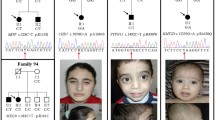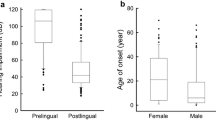Abstract
This paper presents a mutation as well as a genotype–phenotype analysis of the GJB2 and GJB6 genes in 476 samples from non-syndromic unrelated Argentinean deaf patients (104 familial and 372 sporadic cases). Most of them were of prelingual onset (82 %) and 27 % were cochlear implanted. Variation of sequences was detected in 171 of the 474 patients (36 %). Overall, 43 different sequence variations were identified in GJB2 and GJB6. Four of them are reported for the first time in GJB2: c.233dupG, p.Ala78Ser, p.Val190Asp and p.Cys211Tyr. Mutations in GJB6 were detected in 3 % of patients [nine del(GJB6-D13S1830) and three del(GJB6-D13S1854)]. Of the 43 different variations identified in GJB2, 6 were polymorphisms and of the others, 10 (27 %) were truncating and 27 (73 %) were nontruncating. Patients with two truncating mutations had significantly worse hearing impairment than all other groups. Moderate phenotypes were observed in a group of patients carrying biallelic mutations (23 %). This work shows the high prevalence of GJB2 mutations in the Argentinean population and presents an analysis of moderate phenotypes in our cohort.






Similar content being viewed by others
References
Cremers CW, Marres HA, van Rijn PM (1991) Nonsyndromal profound genetic deafness in childhood. Ann N Y Acad Sci 630:191–196
Morton NE (1991) Genetic epidemiology of hearing impairment. Ann N Y Acad Sci 630:16–31
Van Camp G, Willems PJ, Smith RJ (1997) Nonsyndromic hearing impairment: unparalleled heterogeneity. Am J Hum Genet 60(4):758–764
Kelley PM et al (1998) Novel mutations in the connexin 26 gene (GJB2) that cause autosomal recessive (DFNB1) hearing loss. Am J Hum Genet 62(4):792–799
Scott DA, Carmi R, Kraft ML, Ramesh A, Elbedour K, Yairi Y, Srisailapathy CR, Rosengren SS, Markham AF, Mueller RF, Lench NJ, Van Camp G, Smith RJ, Sheffield VC (1998) Identification of mutations in the connexin 26 gene that cause autosomal recessive nonsyndromic hearing loss. Hum Mutat 11(5):387–394
Zelante L et al (1997) Connexin26 mutations associated with the most common form of non-syndromic neurosensory autosomal recessive deafness (DFNB1) in Mediterraneans. Hum Mol Genet 6(9):1605–1609
Dalamon V et al (2010) GJB2 and GJB6 genes: molecular study and identification of novel GJB2 mutations in the hearing-impaired Argentinean population. Audiol Neurootol 15(3):194–202
Gravina LP et al (2007) Carrier frequency of the 35delG and A1555G deafness mutations in the Argentinean population. Impact on the newborn hearing screening. Int J Pediatr Otorhinolaryngol 71(4):639–643
Snoeckx RL et al (2005) GJB2 mutations and degree of hearing loss: a multicenter study. Am J Hum Genet 77(6):945–957
Denoyelle F et al (1999) Clinical features of the prevalent form of childhood deafness, DFNB1, due to a connexin-26 gene defect: implications for genetic counselling. Lancet 353(9161):1298–1303
Kenna MA et al (2010) Audiologic phenotype and progression in GJB2 (Connexin 26) hearing loss. Arch Otolaryngol Head Neck Surg 136(1):81–87
Dalamon V et al (2005) Prevalence of GJB2 mutations and the del(GJB6-D13S1830) in Argentinean non-syndromic deaf patients. Hear Res 207(1–2):43–49
del Castillo FJ et al (2005) A novel deletion involving the connexin-30 gene, del(GJB6-d13s1854), found in trans with mutations in the GJB2 gene (connexin-26) in subjects with DFNB1 non-syndromic hearing impairment. J Med Genet 42(7):588–594
Del Castillo I et al (2003) Prevalence and evolutionary origins of the del(GJB6-D13S1830) mutation in the DFNB1 locus in hearing-impaired subjects: a multicenter study. Am J Hum Genet 73(6):1452–1458
Guex N, Peitsch MC (1997) SWISS-MODEL and the Swiss-PdbViewer: an environment for comparative protein modeling. Electrophoresis 18(15):2714–2723
Canutescu AA, Shelenkov AA, Dunbrack RL Jr (2003) A graph-theory algorithm for rapid protein side-chain prediction. Protein Sci 12(9):2001–2014
Altschul SF et al (1990) Basic local alignment search tool. J Mol Biol 215(3):403–410
Guerois R, Nielsen JE, Serrano L (2002) Predicting changes in the stability of proteins and protein complexes: a study of more than 1000 mutations. J Mol Biol 320(2):369–387
Humphrey W, Dalke A, Schulten K (1996) VMD: visual molecular dynamics. J Mol Graph 14(1): 33-8–27-8
Hilgert N et al. (2009) Phenotypic variability of patients homozygous for the GJB2 mutation 35delG cannot be explained by the influence of one major modifier gene. Eur J Hum Genet 17:517–524
Maeda S et al (2009) Structure of the connexin 26 gap junction channel at 3.5 Å resolution. Nature 458(7238):597–602
Morell RJ et al (1998) Mutations in the connexin 26 gene (GJB2) among Ashkenazi Jews with nonsyndromic recessive deafness. N Engl J Med 339(21):1500–1505
Liu XZ et al (2002) The prevalence of connexin 26 (GJB2) mutations in the Chinese population. Hum Genet 111(4–5):394–397
Samanich J et al (2007) Mutations in GJB2, GJB6, and mitochondrial DNA are rare in African American and Caribbean Hispanic individuals with hearing impairment. Am J Med Genet A 143A(8):830–838
Esmaeili M, Bonyadi M, Nejadkazem M (2007) Common mutation analysis of GJB2 and GJB6 genes in affected families with autosomal recessive non-syndromic hearing loss from Iran: simultaneous detection of two common mutations (35delG/del(GJB6-D13S1830)) in the DFNB1-related deafness. Int J Pediatr Otorhinolaryngol 71(6):869–873
Neocleous V et al (2006) High frequency of 35delG GJB2 mutation and absence of del(GJB6-D13S1830) in Greek Cypriot patients with nonsyndromic hearing loss. Genet Test 10(4):285–289
Azaiez H et al (2004) GJB2: the spectrum of deafness-causing allele variants and their phenotype. Hum Mutat 24(4):305–311
Denoyelle F et al (1997) Prelingual deafness: high prevalence of a 30delG mutation in the connexin 26 gene. Hum Mol Genet 6(12):2173–2177
Huculak C et al (2006) V37I connexin 26 allele in patients with sensorineural hearing loss: evidence of its pathogenicity. Am J Med Genet A 140(22):2394–2400
Palmada M et al (2006) Loss of function mutations of the GJB2 gene detected in patients with DFNB1-associated hearing impairment. Neurobiol Dis 22(1):112–118
Bruzzone R et al (2003) Loss-of-function and residual channel activity of connexin26 mutations associated with non-syndromic deafness. FEBS Lett 533(1–3):79–88
D’Andrea P et al (2002) Hearing loss: frequency and functional studies of the most common connexin26 alleles. Biochem Biophys Res Commun 296(3):685–691
Li L, Lu J, Tao Z, Huang Q, Chai Y et al (2012) The p.V37I exclusive genotype of GJB2: a genetic risk-indicator of postnatal permanent childhood hearing impairment. PLoS One 7(5): e36621
Connell SS et al (2007) Performance after cochlear implantation in DFNB1 patients. Otolaryngol Head Neck Surg 137(4):596–602
Sinnathuray AR et al (2004) Connexin 26 (GJB2) gene-related deafness and speech intelligibility after cochlear implantation Auditory perception and speech discrimination after cochlear implantation in patients with connexin 26 (GJB2) gene-related deafness. Otol Neurotol 25(6):935–942
Sinnathuray AR et al (2004) Auditory perception and speech discrimination after cochlear implantation in patients with connexin 26 (GJB2) gene-related deafness. Otol Neurotol 25(6):930–934
Acknowledgments
We would like to thank all families that participated in this study. This study was supported by an International Research Scholar grant from the Howard Hughes Medical Institute and the Tinnitus Research Initiative to Ana Belen Elgoyhen and by ANPCyT, Argentina, to Viviana Dalamon. María Florencia Wernert is a CONICET fellow.
Conflict of interest
The authors declare no conflicts of interest.
Author information
Authors and Affiliations
Corresponding author
Rights and permissions
About this article
Cite this article
Dalamón, V., Florencia Wernert, M., Lotersztein, V. et al. Identification of four novel connexin 26 mutations in non-syndromic deaf patients: genotype–phenotype analysis in moderate cases. Mol Biol Rep 40, 6945–6955 (2013). https://doi.org/10.1007/s11033-013-2814-x
Received:
Accepted:
Published:
Issue Date:
DOI: https://doi.org/10.1007/s11033-013-2814-x




